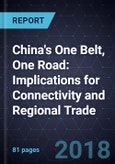Emergence of Lucrative Trade Corridors Laying Foundation for a Network of Intercontinental Multimodal Logistics
Lack of seamless connectivity and poor infrastructure remain the major challenges for trade and logistics in many countries in the Eurasian region. China’s One Belt One Road (OBOR) initiative is expected to improve connectivity by inter-linking the transport infrastructure across East Asia, Southeast Asia, South Asia, Central Asia, Middle East, East Africa and European countries. It will help China to overcome some of the problems associated with its domestic economy such as a decline in export competitiveness due to increasing labor cost and excess capacity. Further, it will lead to improved connectivity to support the international expansion of domestic companies of the major trading partners along OBOR.
Developments of projects relating to OBOR are likely to be undertaken in phased manner at different time periods due to financial constraints, local administrative hurdles, pending clearances from government agencies, and, in some cases, public unrest due to a lack of transparency in funding allocation – i.e., absence of international standards on transparency, the rule of law, and adequate financing for projects. Macroeconomic stability, long-term impact on employment, industrial growth, infrastructure finance, and the capacity to service debt funds secured from international and infrastructure development institutions of participating OBOR countries are some of the key factors likely to determine the success of this massive exercise. Clarity relating to dispute handling mechanisms concerning OBOR related projects is expected to remain an important factor in determining the success of the projects. To this end, an international commercial court is being set up in Beijing to resolve any project related disputes.
Research Scope
The aim of this insight is to research and analyze the key developments relating to the China's One Belt, One Road initiative and assess the likely implications to the economy, trade, freight transportation, and warehousing sectors across Asia, Middle East, Africa, and Europe.
Research Highlights
This study specifically focuses on the development of economic corridors relating to BRI with focus on improving connectivity with Europe, Central Asia, Middle East and East Africa, South Asia and Southeast Asia. Current and expected growth trends in trade are analyzed to evaluate potential implications for cross-border trade, connectivity, multimodal logistics, and the overall trade growth. New trade routes along the OBOR would enhance multimodal transportation across Asia, Middle East, Africa, Central Asia, and Europe, resulting in estimated trade volumes with China to around $3 Trillion by 2030.
Key Findings
- Infrastructure developments across all modes of transport would result in a shift in the modal mix from a road-dependent modal to a more balanced modal. This shift will augment the establishment of a sustainable transport system and encourage the usage of multimodal transportation. Connecting network of maritime terminals with inland ports and the development of major distribution and logistics hubs in the Middle East, Central Asia and Eastern Europe will help handle cross-border trade volumes. Rail-road connectivity in landlocked Central Asian countries will service major distribution hubs and economic zones.
- The availability of adequate transport infrastructure is expected to have a favorable impact on promoting the economic development of countries due to the development of economic zones and industrial parks, innovation centers, logistics parks, bonded warehouses, and cold chain logistics facilities. Moreover, investments in industrialization tend to move into locations with adequate transport infrastructure. Development of industrial cities and special economic zones along the Silk Road is expected to boost the demand for specialized logistics services such as cold chain logistics, built-to-suit warehouses, and on-demand transportation services.
- With rising labor cost issues, Chinese manufacturers are shifting their industrial bases to the country’s interior and other landlocked regions such as Chongqing and Chengdu, to reduce the cost of production. In some cases, projects are relocated to low-cost ASEAN countries. Thus, efficiency of connectivity becomes an important part of their expansion strategy to move raw materials and finished goods across regions. Development of the Silk Road across the region will facilitate manufacturers to establish better connectivity with key export destinations with sufficient transport mode options such as high-speed rail, highways, and modern ports. These factors would enable them to experiment on multimodal transportation.
- The trade between Asia and Europe is significant and growing at a consistent pace. Driven by the high demand from Europe, automotive, consumer electronics, cosmetics, and toys are some of the major industry clusters that will benefit from the Silk Road. Most manufacturers would rely on third-party service providers to manage their logistics services. The logistics companies will prepare solutions including transportation and distribution, warehousing and fulfillment, integrated logistics, and multimodal transport solutions to meet the growing needs.
- eCommerce is growing at a rapid pace, and China is one of the most preferred destinations for online shoppers worldwide, especially those from Europe, driven by the lower prices and wide variety of product offerings. Fulfillment of online orders within shorter timelines and at lower costs still remains a major challenge in the cross-border eCommerce industry. With development of the new routes, the transport time and costs between Asia and China would be reduced significantly.
Key Features
- To provide an overview of the China's OBOR initiative and identify the measures undertaken by governments to improve freight transportation efficiency and reduce logistics costs
- To provide an in-depth analysis on the development of economic corridors and analyze the role of transportation and logistics sector in driving growth
- To provide a holistic view on how the trade is expected to transform as a result of infrastructure developments, cross-border eCommerce growth, and development of economic zones
- To assess the expected changes in China's trade with the Silk Road participating nations by 2030 and provide implications for the overall logistics growth in these regions
- To analyze the industry segments that would pop up along the routes and identify the potential opportunities for the logistics participants.








